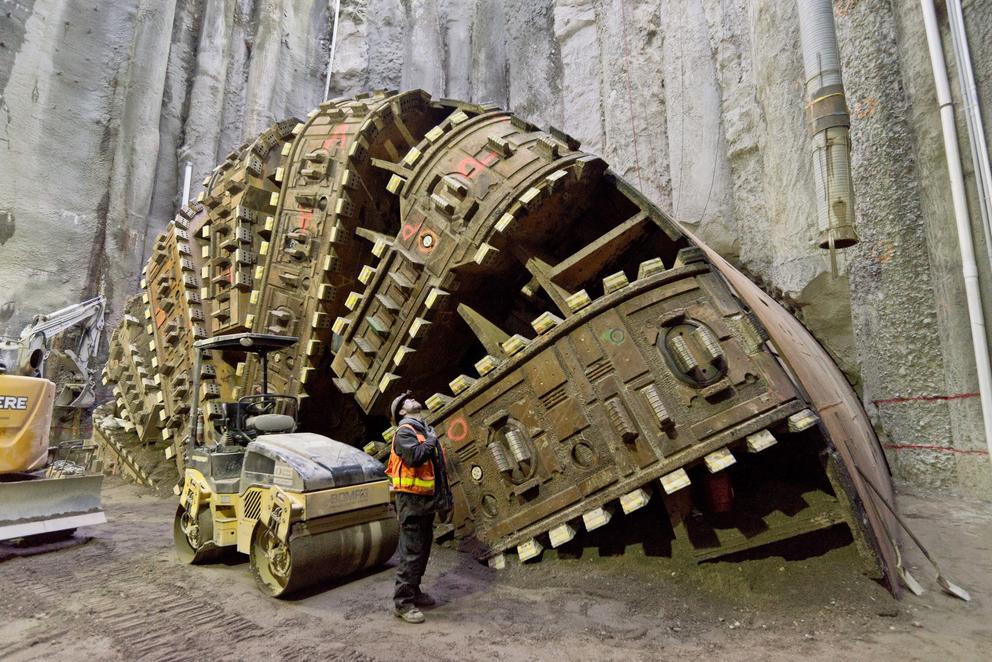Nothing makes a tunnel guy as happy as actually tunneling. And on Thursday that guy was Chris Dixon, head of Seattle Tunnel Partners, the contractor group responsible for operating Seattle’s favorite tunnel boring machine, Bertha.
Bertha busted through the walls of her cage – a 120-foot-deep access pit made of concrete – late on Wednesday evening. Since then, she’s been a regular racehorse, traveling about 57 feet through pure, native soil. Combined with the distance inside the pit, that’s a total of 72 feet from when crews started her up again on December 22.
In a telephone conference with media Thursday, Dixon was upbeat: “All of the operational parameters are right at where they should be.”
“It’s very good to be tunneling again,” he said later. “That’s what we came here to do.”
Seattle was meant to have a fully operational tunnel by December 2015. But after 1,019 feet (11 percent of the way to the north portal in South Lake Union) the machine ground to a steaming halt. That was more than two years ago. Upon dissection, crews found that the seals behind the massive rotating cutterhead had disintegrated. As a result, the machine not only overheated, but allowed a huge amount of grit into its gears.
The damage was so extensive and the machine so unique that just repairing Bertha was a megaproject in and of itself. It required not only digging the pit (just 20 feet from the viaduct), but also importing a specially built crane to lift each piece to the surface.
Why did it fail? Some (such as the folks at STP) like to say it was because of a run-in with a steel pipe left behind by the state. The state, however, vigorously denies that. Both sides are careful about what they say, given the years and years of lawsuits that are sure to come. When you consider the number of parties involved in this project -- the State, the machine’s manufacturer, Hitachi-Zosen, the bottomless pit of contractors and subcontractors that make up Seattle Tunnel Partners – determining who should pay for what is right up there with the koans of Zen Buddhism in transcending the power of rational thought.
Bertha is still technically in testing mode as it moves through the soil below Alaskan Way and Main Street. After slowly crunching through the concrete wall, the machine picked up speed to about 25 millimeters per minute, or around 60 inches an hour. In tunnel speak, progress is measured in rings – the concrete circles that keep the ground from falling in on you. Each ring is six and a half feet. Since the machine started before Christmas, crews have finished 12 rings, completing five just yesterday.
At full speed, the machine could do up to eight rings in a day.

If all goes well, Bertha will reach safe haven number three by the end of the month. The stop, 400 feet away near Yesler, is a planned, month-long break for the machine so crews can give it a thorough inspection before it takes a deep breath and dives beneath the viaduct.
Crews will be busting their tails for the foreseeable future, working on a 24-hour, two-shift rotation. Each crew will work 12 hours a day, 6 days a week before going under the viaduct. Once the machine is under the highway, they’ll move to 7 days a week.
Dixon acknowledged that such a schedule allowed little time for things such as sleep and said, ideally, the crews will eventually work closer to 50 hours a week. "We’re looking very closely at what we can do ... so we're not in a mode where our crews aren’t sufficiently rested," he said. He wouldn't say when that would happen, but that they were working on it.
The crumbling elevated freeway will be closed as the machine burrows below it, so crews can monitor settlement and the safety of the highway. Todd Trepanier, project administrator for the Washington Department of Transportation, said, however, that he has full confidence the viaduct won’t be affected by the machine.
Confidence aside, the skeptics aren’t going anywhere. Trepanier said there was no contingency plan in case of an emergency closure of the viaduct, exactly, but that the city has scenarios it can activate depending on conditions.
At this pace, Bertha’s job will be done by this time next year and the road inside the tunnel will be finished by April 2018. Dixon said that his confidence in success was high, citing better soil conditions. But with the machine’s latest burst of movement, the project is averaging a little over a foot of progress a day from the time it began tunneling. With that speed, you really can’t blame anyone for a “I’ll believe it when I see it” attitude.



